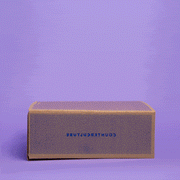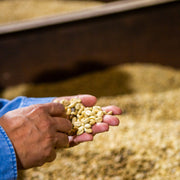by Katie Carguilo, Coffee Manager
During my trip to visit Indian coffee producers in March 2024, I had the incredible opportunity to tour India’s Central Coffee Research Institute (CCRI). As the guardian of some of the oldest and rarest coffee varieties in the world, CCRI has played a fascinating, if underappreciated, role in coffee's history. Now, working alongside World Coffee Research (WCR), CCRI holds immense potential for coffee’s future. It was truly inspiring to learn more about coffee varieties in India and share this amazing story.
Counter Culture Coffee is a founding member and supporter of World Coffee Research. In addition, I (Katie Carguilo) have served on the WCR board since 2023.
What is a coffee variety?
A coffee variety refers to a cultivar of the Coffea plant. Within the species, there are numerous varieties, each with distinct characteristics affecting flavor, growth, and resistance to diseases.
Coffea arabica varieties originally grew wild in the forests of Ethiopia. In the 15th century, Ethiopian coffee plants were brought to Yemen and cultivated. From there, plants were taken to establish coffee farms in tropical regions worldwide, often through colonial expansion.
The Past: Coffee Cultivation’s Beginnings in India
India has a rich history of coffee cultivation, featuring some of the oldest coffee varieties in the world. The journey began in the 1600s with Baba Budan, a Sufi saint who smuggled seven coffee seeds out of Yemen. It is widely believed that Baba Budan carried both Bourbon and Typica strains to India, where they were cultivated as garden plants for the next two centuries.
In the early 18th century, the British initiated commercial production and export of coffee, leading to growth in the industry. However, this prosperity was short-lived as coffee plantations faced devastating outbreaks of pests and diseases. In 1863, white stem borer beetles began ravaging farms, followed by a rust epidemic that spread from Sri Lanka in 1869.

Chandragiri coffee trees blooming at Gundikhan Estate
Indian farmers planted coffee under dense shade to protect their crops from these threats, a practice that continues today. Coffee varieties also played a role in mitigation. Coorg was developed by Stanley Jupp in 1870 with resistance to rust. In the early 1900s, Mr. Jackson, a coffee farmer in Mysore, India, noticed some trees on his farm—Jackson, Kent, and Mysore—were more rust tolerant. These selections gained popularity for their rust resistance, though they struggled to meet the productivity demands of a global coffee market.
Amidst these challenges, India established the Central Coffee Research Institute (CCRI) in 1925. Initially focused on understanding and cataloging coffee varieties, CCRI later shifted towards breeding to enhance resilience.
How is a coffee variety developed?
Developing a new coffee variety begins with selecting parent plants that have desirable traits like disease resistance and good flavor. Researchers then perform controlled pollination to combine these traits. The resulting seeds are planted to grow the first generation of hybrid plants. The best plants are selected for backcrossing, where they are bred with parent plants to stabilize desirable characteristics. This backcrossing process is repeated over several generations to ensure consistency before commercial release.
The Present: CCRI’s Variety Development to Date
The success of any breeding program relies on its genetic resources. CCRI is fortunate to have both a large indigenous germplasm bank from collections on India’s farms as well as an extensive collection acquired internationally.
To date, CCRI has released 13 distinct coffee varieties in India, including:
SLN 1 (S.288): A selection of S.26, an interspecific hybrid between C.arabica and C. Liberica. Released in 1936-37.
SLN 3 (S. 795): S.288 x Kents. Released in 1945-46.
SLN 4 (Cioccie): Ethiopian pure selection composite of three collections––Cioccie, Agaro, Tafarikela
SLN 5A: Devamachi x S.881 Devamachy is an interspecific hybrid between C.arabica and C.canephora first discovered on a private estate in Coorg. S.881 is Sudan Rume.
SLN 5B: Devamachi x S.333. S.333 is S.2931
SLN 6 (S. 2828): S. 274 x Kents
SLN 7: San Ramon x Other arabicas
SLN 7.3: S. 2498 x HdT
SLN 8: Pureline selection of the spontaneous hybrid of C.arabica and C.canephora (aka Hibrido De Timor, or HdT). HdT was introduced to India in 1961.
SLN 9: HdT x Tafarikela. A cross between Ethiopian arabica and Timor Hybrid. Known for its cup quality, but susceptible to rust.
SLN 10: (Caturra x Cioccie) x (Catura x S. 795)
SLN 11: Tetraploid interspecific hybrid of C.liberica x C.eugenioides.
SLN: 12: Caturra x HdT (aka Catimor). Given to CCRI by CRRC Portugal in 1985 under the name ‘Cauvery.’
SLN 13 (Chandragiri): Villasarchi x HDT (aka Sarchimor). Introduced through the research center in Portugal (CRC Portugal) and released in 2007 in its F3 generation. Fairly rust-resistant.
Out of these, SLN 9 and Chandragiri are currently the most popular in cultivation.
A note on interspecific hybrids: Interspecific hybrids are especially valuable in breeding programs because species are much more genetically diverse than two varieties of the same species. However, different Coffea species have different chromosome numbers which makes them incompatible for breeding. Among the two main cultivated species of coffee, C.arabica has four sets of chromosomes, while C.canephora has two. Therefore, Timor Hybrid (HdT), a spontaneous progeny of these two species, is particularly noteworthy and valuable. HdT is widely used in Arabica breeding programs because it combines the robust characteristics of Robusta plants with the four chromosomes of Arabica.
The Future: CCRI x World Coffee Research
Coffee breeding timelines are long: it takes years for the plant to mature, and many generations of backcrossing to develop seed-stable varieties. The uncertainty of genetic performance further complicates the process, as some varieties may prove less suitable over time in certain environments. Out of thirteen varieties introduced by CCRI in India, only two have sustained popularity; the rest were abandoned by farmers due to poor performance or eventual susceptibility to diseases in the field.

A sign for the IMLVT area at CCRI
Field testing and research can help breeders understand and predict performance, however, it’s expensive and time-consuming and most countries are limited to the environmental diversity within their borders. World Coffee Research (WCR), a non-profit organization established in 2012, is helping the coffee industry overcome these obstacles by uniting the coffee industry to advance coffee breeding programs. When WCR conceived of its variety development programs, CCRI was at the top of their list of ideal collaborators due to their history of variety research and advancement.
WCR’s International Multi Location Variety Trial (IMLVT) distributed 31 top-performing coffee varieties to 29 test plots with diverse conditions. Among the IMLVT set are four Indian selections CCRI donated for research. Since 2016, the trial has gathered comprehensive data on yield, disease resistance, and cup quality and WCR has used that information to inform producers on variety performance for their farms.

Coffee plots at CCRI’s research station in Balehonnur, Karnataka
CCRI’s IMLVT plot is situated at a relatively low elevation of 855 meters. The coffee trees are planted under heavy shade to mimic the country’s average production standards. The plot evaluates 28 of the 31 varieties included in the trial against India’s top local strains, SLN 9 and Chandragiri. During my visit, CCRI’s researchers shared with me that most of the plants in their set—save for the hybrids—had suffered from rust on their plot. This susceptibility, even under shade, is a crucial metric to understand as breeders develop varieties for a global coffee farming climate that continues to change. Insights like these are precisely what distinguish a good breeding program from a great one, and are what set WCR and its partners apart from other organizations in the industry.
In addition to the IMLVT, CCRI is participating in WCR’s Innovea Global Coffee Breeding Network for arabica. Through Innovea, they test newly bred coffee varieties generated from crosses made by WCR scientists for planting and field evaluation. The staff I spoke with were immensely excited about their involvement in Innovea and WCR’s forthcoming complementary robusta network, as India cultivates both species. They highlighted benefits like advanced equipment, new genetic materials, and connections with global coffee researchers. By 2030, CCRI plans to release new varieties to Indian coffee farmers based on field tests and additional breeding with the materials.

Diyva Kallingapuram Das holding a robusta plant graft at CCRI
Every cup of coffee begins with a plant. While genetics might not be the first thing that comes to mind when thinking about the quality and sustainability of the coffee we drink, they are crucial for both those aspects. Researching and developing coffee plants hold immense potential to improve outcomes for all, if they're invested in. By sharing this story of variety development in one origin, I hope to inspire enthusiasm and support for the all dedicated scientists and institutions working to secure the future of our beloved coffee.

Left to right: Dr. Mayappamuniyan Senthilkumar, Dinesh Pejathaya, Katie Carguilo, Dr. Diyva Kallingapuram Das





